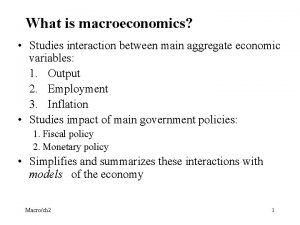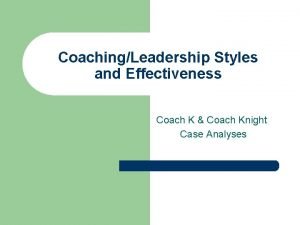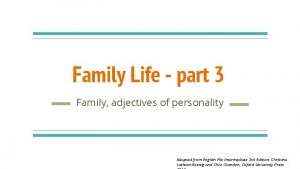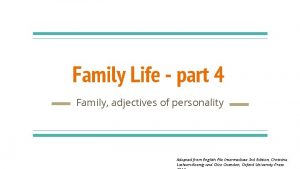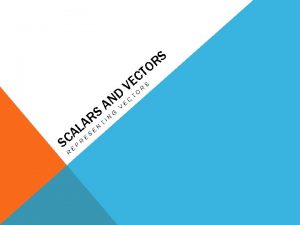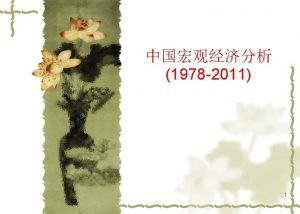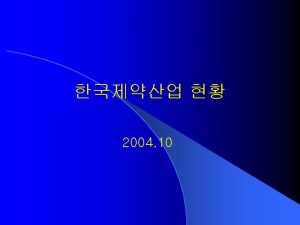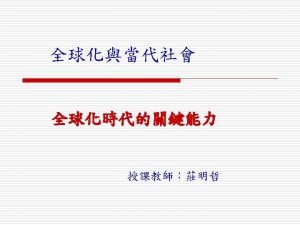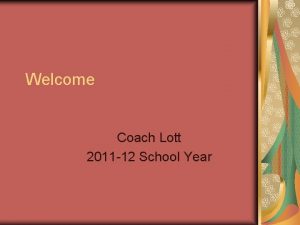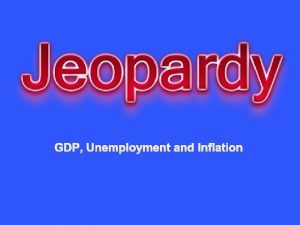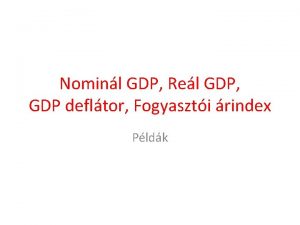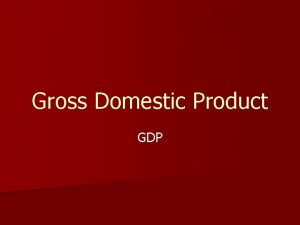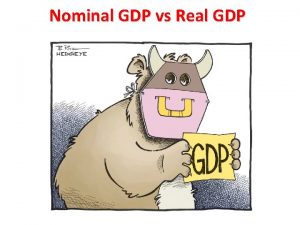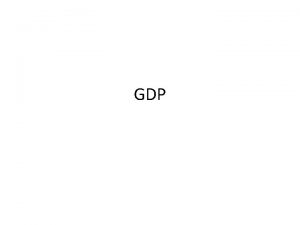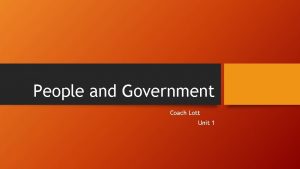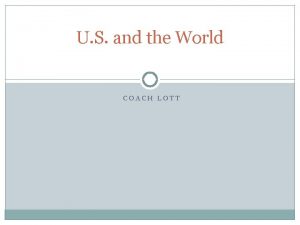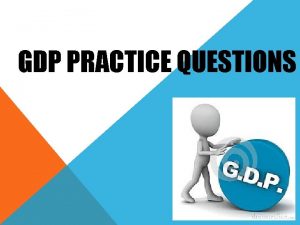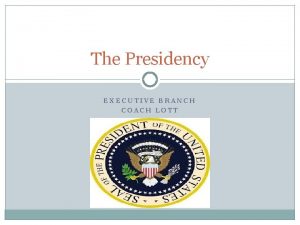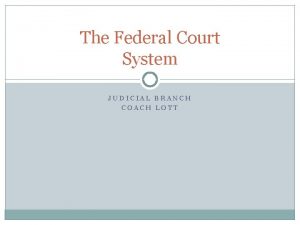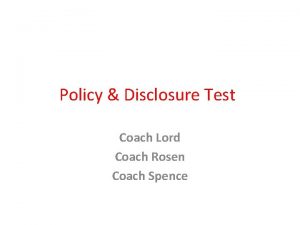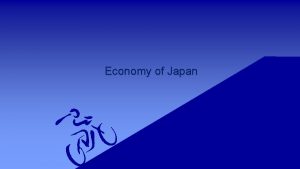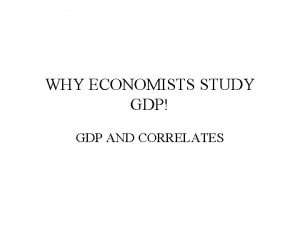GDP and the Economy UNIT 3 COACH LOTT























































- Slides: 55

GDP and the Economy UNIT 3 COACH LOTT

What Is Gross Domestic Product? • Economists monitor the macro-economy using national income accounting, a system that collects statistics on production, income, investment, and savings. • Gross domestic product (GDP) is the dollar value of all final goods and services produced within a country’s borders in a given year. • GDP does not include the value of intermediate goods. Intermediate goods are goods used in the production of final goods and services.

Calculating GDP The Expenditure Approach � The expenditure approach totals annual expenditures on four categories of final goods or services. 1. consumer goods and services 2. business goods and services 3. government goods and services 4. net exports or imports of goods or services. �C + I + G + (X-M) = GDP The Income Approach � The income approach calculates GDP by adding up all the incomes in the economy

Types of Goods �Consumer goods include durable goods, goods that last for a relatively long time like refrigerators, and nondurable goods, or goods that last a short period of time, like food and light bulbs

Nominal vs. Real GDP �Nominal GDP is GDP measured in current prices. It does not account for price level increases from year to year. �Real GDP is GDP expressed in constant, or unchanging, dollars

Nominal vs. Real GDP

Limitations of GDP �GDP does not take into account certain economic activities, such as:

Factors Influencing GDP Aggregate Supply �Aggregate supply is the total amount of goods and services in the economy available at all possible price levels. �As price levels rise, aggregate supply rises and real GDP increases. Aggregate Demand �Aggregate demand is the amount of goods and services that will be purchased at all possible price levels. �Lower price levels will increase aggregate demand as consumers’ purchasing power increases.

AS/AD Equilibrium Aggregate Supply/Aggregate Demand Equilibrium �By combining aggregate supply curves and aggregate demand curves, equilibrium for the macro-economy can be determined.

Business Cycles �A business cycle is a macroeconomic period of expansion followed by a period of contraction. �A modern industrial economy experiences cycles of good times, then bad times, then good times again. �Business cycles are of major interest to macroeconomists, who study their causes and effects. �There are four main phases of the business cycle: expansion, peak, contraction, and trough

Phases of the Business Cycle Expansion • An expansion is a period of economic growth as measured by a rise in real GDP. Economic growth is a steady, long-term rise in real GDP. Peak • When real GDP stops rising, the economy has reached its peak, the height of its economic expansion. Contraction • Following its peak, the economy enters a period of contraction, an economic decline marked by a fall in real GDP. A recession is a prolonged economic contraction. An especially long or severe recession may be called a depression. Trough • The trough is the lowest point of economic decline, when real GDP stops falling.

Business Cycles

How long is a Recession?

Job Loss during 2007 -09 Recession

What keeps Cycles Going? Business cycles are affected by four main economic variables:

Forecasting Business Cycles • Economists try to forecast, or predict, changes in the business cycle. • Leading indicators are key economic variables economists use to predict a new phase of a business cycle. • Examples of leading indicators are stock market performance, interest rates, and new home sales.

Business Cycle Fluctuations The Great Depression was the most severe downturn in the nation’s history. Between 1929 and 1933, GDP fell by almost one third, and unemployment rose to about 25 percent. Later Recessions In the 1970 s, an OPEC embargo caused oil prices to quadruple. This led to a recession that lasted through the 1970 s into the early 1980 s. U. S. Business Cycles in the 1990 s Following a brief recession in 1991, the U. S. economy grew steadily during the 1990 s, with real GDP rising each year. � Great Recession of 2008: Caused by a housing bubble. Most severe downturn since the Great Depression. Over 9 million jobs were lost over a two year period.

Measuring Economic Growth The basic measure of a nation’s economic growth rate is the percentage change of real GDP over a given period of time. GDP and Population Growth • In order to account for population increases in an economy, economists use a measurement of real GDP per capita. It is a measure of real GDP divided by the total population. • Real GDP per capita is considered the best measure of a nation’s standard of living. GDP and Quality of Life • Like measurements of GDP itself, the measurement of real GDP per capita excludes many factors that affect the quality of life.

Capital Deepening • The process of increasing the amount of capital per worker is called capital deepening. Capital deepening is one of the most important sources of growth in modern economies. • Firms increase physical capital by purchasing more equipment. Firms and employees increase human capital through additional training and education.

The Effects of Savings and Investing • The proportion of disposable income spent to income saved is called the savings rate. • When consumers save or invest, money in banks, their money becomes available for firms to borrow or use. This allows firms to deepen capital. • In the long run, more savings will lead to higher output and income for the population, raising GDP and living standards.

The Effects of Technological Progress • Besides capital deepening, the other key source of economic growth is technological progress. • Technological progress is an increase in efficiency gained by producing more output without using more inputs. • A variety of factors contribute to technological progress: Innovation When new products and ideas are successfully brought to market, output goes up, boosting GDP and business profits. Scale of the Market Larger markets provide more incentives for innovation since the potential profits are greater. Education and Experience Increased human capital makes workers more productive. Educated workers may also have the necessary skills needed to use new technology.

Other Factors Affecting Growth Population Growth • If population grows while the supply of capital remains constant, the amount of capital per worker will actually shrink. Government • Government can affect the process of economic growth by raising or lowering taxes. Government use of tax revenues also affects growth: funds spent on public goods increase investment, while funds spent on consumption decrease net investment. Foreign Trade • Trade deficits, the result of importing more goods than exporting goods, can sometimes increase investment and capital deepening if the imports consist of investment goods rather than consumer goods.

Economic Challenges �Unemployment �Inflation �Poverty �Income Inequality

Types of Unemployment

Determining the Unemployment Rate • A nation’s unemployment rate is an important indicator of the health of the economy. • The Bureau of Labor Statistics polls a sample of the population to determine how many people are employed and unemployed. • The unemployment rate is the percentage of the nation’s labor force that is unemployed. • The unemployment rate is only a national average. It does not reflect regional economic trends.

Full Employment �Full employment is the level of employment reached when there is no cyclical unemployment • Economists generally agree that in an economy that is working properly, an unemployment rate of around 4 to 6 percent is normal. • Sometimes people are underemployed, that is working a job for which they are over-qualified, or working part-time when they desire full-time work. • Discouraged workers are people who want a job, but have given up looking for one.


Education

Gender and Occupation

The Effects of Rising Prices • Inflation is a general increase in prices. • Purchasing power, the ability to purchase goods and services, is decreased by rising prices. • Price level is the relative cost of goods and services in the entire economy at a given point in time.

Price Indexes A price index is a measurement that shows how the average price of a standard group of goods changes over time. • The consumer price index (CPI) is computed each month by the Bureau of Labor Statistics. • The CPI is determined by measuring the price of a standard group of goods meant to represent the typical “market basket” of an urban consumer. • Changes in the CPI from month to month help economists measure the economy’s inflation rate. • The inflation rate is the percentage change in price level over time.

Calculating Inflation • To determine the inflation rate from one year to the next, use the following steps.

Types of Inflation Creeping Inflation • Creeping inflation is inflation that remains low (1 to 3 percent) for a long time. Sign of an economy growing well. Chronic Inflation • Chronic inflation occurs when the inflation rate rises steadily from month to month over an extended period. Economy growing too fast. Hyperinflation • Hyperinflation is inflation that is growing out of control. Inflation rates may be as high as 100 or even 500 percent. Hyperinflation can sometimes lead to total economic collapse.

Causes of Inflation The Quantity Theory The Cost-Push Theory • The quantity theory of inflation states that too much money in the economy leads to inflation. • • Adherents to this theory maintain that inflation can be tamed by increasing the money supply at the same rate that the economy is growing. According to the cost-push theory, inflation occurs when producers raise prices in order to meet increased costs. • Cost-push inflation can lead to a wage-price spiral — the process by which rising wages cause higher prices, and higher prices cause higher wages.

Causes of Inflation The Demand-Pull Theory • The demand-pull theory states that inflation occurs when demand for goods and services exceeds existing supplies.

Effects of Inflation High inflation is a major economic problem, especially when inflation rates change greatly from year to year.


Who is Poor? The Census Bureau collects data about how many families and households live in poverty. The Poverty Threshold • The poverty threshold is an income level below which income is insufficient to support a family or household. The Poverty Rate • The poverty rate is the percentage of people in a particular group who live in households below the official poverty line.

Causes of Poverty


Income Distribution in the United States Income Inequality • The Lorenz Curve illustrates income distribution. Income Gap • A 1999 study showed that the richest 2. 7 million Americans receive as much income after taxes as the poorest 100 million Americans. • Differences in skills, effort, and inheritances are key factors in understanding the income gap

Lorenz Curve

Government Policies Combating Poverty The government spends billions of dollars on programs designed to reduce poverty. Employment Assistance • The minimum wage and federal and state job-training programs aim to provide people with more job options. Welfare Reform • Temporary Assistance for Needy Families (TANF) is a program which gives block grants to the states, allowing them to implement their own assistance programs. • Workfare programs require work in exchange for temporary assistance.

Gender and Occupation











 Real gdp and nominal gdp
Real gdp and nominal gdp Real gdp formula
Real gdp formula Coach k leadership style
Coach k leadership style Heather lott
Heather lott The younger brother novelist tim lott
The younger brother novelist tim lott James lott script health
James lott script health Adjectives for family
Adjectives for family Lott
Lott Athenian economy vs sparta economy
Athenian economy vs sparta economy Unit 10, unit 10 review tests, unit 10 general test
Unit 10, unit 10 review tests, unit 10 general test Sports coach responsibilities
Sports coach responsibilities Legal and ethical responsibilities of a coach
Legal and ethical responsibilities of a coach Consider a football coach pacing back and forth
Consider a football coach pacing back and forth Draw and label a figure for each relationship
Draw and label a figure for each relationship Hình ảnh bộ gõ cơ thể búng tay
Hình ảnh bộ gõ cơ thể búng tay Slidetodoc
Slidetodoc Bổ thể
Bổ thể Tỉ lệ cơ thể trẻ em
Tỉ lệ cơ thể trẻ em Chó sói
Chó sói Chụp phim tư thế worms-breton
Chụp phim tư thế worms-breton Bài hát chúa yêu trần thế alleluia
Bài hát chúa yêu trần thế alleluia Các môn thể thao bắt đầu bằng tiếng bóng
Các môn thể thao bắt đầu bằng tiếng bóng Thế nào là hệ số cao nhất
Thế nào là hệ số cao nhất Các châu lục và đại dương trên thế giới
Các châu lục và đại dương trên thế giới Công của trọng lực
Công của trọng lực Trời xanh đây là của chúng ta thể thơ
Trời xanh đây là của chúng ta thể thơ Mật thư anh em như thể tay chân
Mật thư anh em như thể tay chân Làm thế nào để 102-1=99
Làm thế nào để 102-1=99 Phản ứng thế ankan
Phản ứng thế ankan Các châu lục và đại dương trên thế giới
Các châu lục và đại dương trên thế giới Thể thơ truyền thống
Thể thơ truyền thống Quá trình desamine hóa có thể tạo ra
Quá trình desamine hóa có thể tạo ra Một số thể thơ truyền thống
Một số thể thơ truyền thống Bàn tay mà dây bẩn
Bàn tay mà dây bẩn Vẽ hình chiếu vuông góc của vật thể sau
Vẽ hình chiếu vuông góc của vật thể sau Biện pháp chống mỏi cơ
Biện pháp chống mỏi cơ đặc điểm cơ thể của người tối cổ
đặc điểm cơ thể của người tối cổ Giọng cùng tên là
Giọng cùng tên là Vẽ hình chiếu đứng bằng cạnh của vật thể
Vẽ hình chiếu đứng bằng cạnh của vật thể Vẽ hình chiếu vuông góc của vật thể sau
Vẽ hình chiếu vuông góc của vật thể sau Thẻ vin
Thẻ vin đại từ thay thế
đại từ thay thế điện thế nghỉ
điện thế nghỉ Tư thế ngồi viết
Tư thế ngồi viết Diễn thế sinh thái là
Diễn thế sinh thái là Các loại đột biến cấu trúc nhiễm sắc thể
Các loại đột biến cấu trúc nhiễm sắc thể Bảng số nguyên tố lớn hơn 1000
Bảng số nguyên tố lớn hơn 1000 Tư thế ngồi viết
Tư thế ngồi viết Lời thề hippocrates
Lời thề hippocrates Thiếu nhi thế giới liên hoan
Thiếu nhi thế giới liên hoan ưu thế lai là gì
ưu thế lai là gì Sự nuôi và dạy con của hươu
Sự nuôi và dạy con của hươu Sự nuôi và dạy con của hươu
Sự nuôi và dạy con của hươu Sơ đồ cơ thể người
Sơ đồ cơ thể người Từ ngữ thể hiện lòng nhân hậu
Từ ngữ thể hiện lòng nhân hậu Thế nào là mạng điện lắp đặt kiểu nổi
Thế nào là mạng điện lắp đặt kiểu nổi

